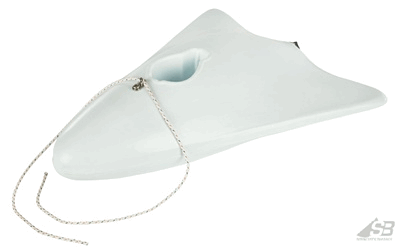"Pillow" Mast Float on a rotating mast (experimental modified C15)
I sail this boat a lot, probably averaging about 25 days per year or more and its mostly high elevation / mountain lake / gusty wind sailing. I of course don't intend to get knocked down but despite all the "practice" I have on this boat, my past history says I'm going to get knocked down about once every 20 to 25 sailing sessions.. Very early in this boat ownership, I put on a Hobie Bob (after turtleing the boat) and it has made the knockdowns almost no problem as the mast tip floats keeping the boat essentially dry and this little boat is very easy to upright by standing on the centerboard.
However... The Hobie Bob is intended to float a much heavier mast than I have on this little boat (used to be a C15, its now an experiment boat with 200 pounds of ballast and a rotating mast). I don't know about the newer plastic hull Hobie cats but both the H14 and H16 have considerably heavier masts than the C15. While I really like having the mast float (a LOT), when considering sailing performance, it only adds drag and weight at the very top of the mast which happens to be about the worst place to add weight. So in the winter of 2013, 2014, I decided to reduce the weight, volume and height of the float drag. I also gave the new float a little aerodynamic lift that will accelerate a small amount of air downwards in the remote chance that it will affect the sail tip vortex in a positive way. I think the chances tip Vortex improvement are extremely small or none - but I likely did reduce the drag, definitely reduced the weight and height.
There is also some chance that the shape of the pillow float will increase the tendency to heel the boat at high heel angles. However, I give this about the same chance of being an issue as the chance of reducing tip vortex and the difference between the Hobie Float that I have been using for a few seasons and the pillow float will likely be very small. The Hobie float still has a lot more surface area (parasitic drag) than the pillow float at for all points of view.
Picture below. The new foam/glass/epoxy pillow float is about 1 pound lighter than the Hobie Bob and considerably lower. But it also has less volume/ floatation.
Float test
The boat was intentionally tipped over in shallow water to make sure the float worked. This boat is stable on its side but takes very little effort to bring it back up which is one of the things I like about this boat. If the boat goes over enough to allow water to enter the inner hull, this is a bad thing as it does not take much water to make the boat unstable. Keep in mind that this boat has two 80 pound bags of concrete plus a group 24 battery (in "theory" about 200 pounds total) just under the mast and as low as possible in the hull. I also had the outboard on the low side to make sure that it also stayed dry.
Picture below. The water level stays below the cubby opening by about 5 inches. I have had the boat go over like this in the past and no water got into the inner hull.
Picture below. The top half of the mast is also sealed "just in case".
Picture below. In this position, about half the float is still above water as well as almost all of the sealed mast (top half). So there is a lot of "reserve" buoyancy - which is good as there are other variables that will happen such as high winds and waves and possibly someone hanging on the boat.
Construction details
Picture below - pink Styrofoam from the hardware store was used to form the shape of the new float. Fiberglass/ epoxy forms the outer shell.
Picture below. Since the new float is lower volume than the Hobie Bob, I also made sure that at least the top halve of the mast will float. Over the years, this mast has had screw holes drilled in it by previous owners and I am also responsible for a few. Every place on the lower end of the mast where there was a hole drilled, I injected in 'great stuff" spray foam by putting the small plastic tube of the spray foam tightly up to the screw hole in the mast. I had no problem injecting foam into all these holes. This results in the mast having multiple foam plugs inside the mast separated by air pockets.. I wanted to make sure the very top of the mast was not only air tight but also had Styrofoam. I did this with a bunch of about 5 inch long foam pieces as shown in the picture below. The very top of these foam pieces in the mast were once again sealed with spray foam and silicon to insure the very top of the mast is water tight.
Picture below. The new Pillow float total weight is about 0.6 pounds. The rotating mast allows the float to be better oriented with the apparent wind flow.
Other options for .solving the problem: http://www.tridentuk.com/sailing/Wayfarer_Anti_Capsize_Cushions_And_Mast_Floats.html
Besides the Hobie Bob float, there is also a float called the "Vago mast head float" (Google what is in the parenthesis). I have no idea how well the Vago float works, I believe it was designed for a Laser Vago (4.2 meters). I found this after building the pillow float but they look at least a little bit similar.
